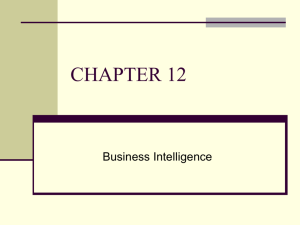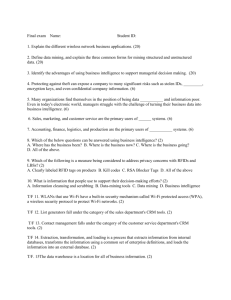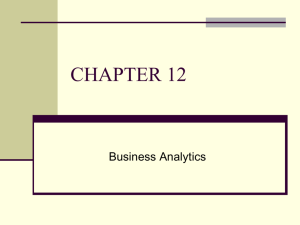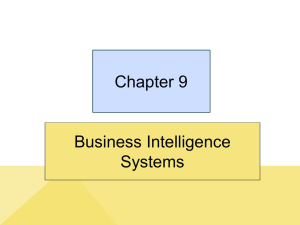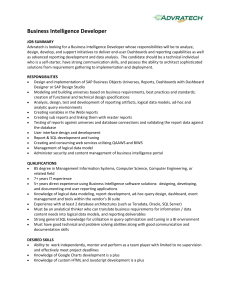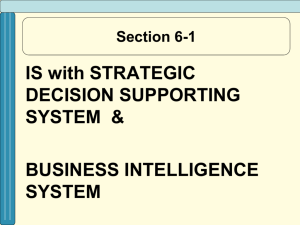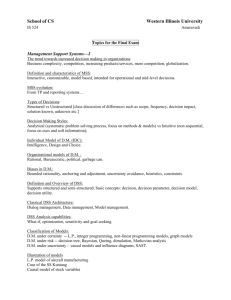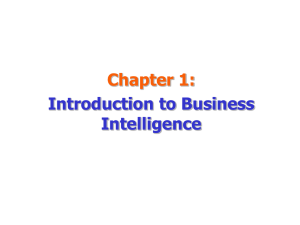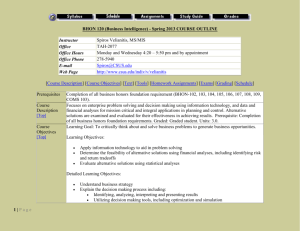Business Intelligence
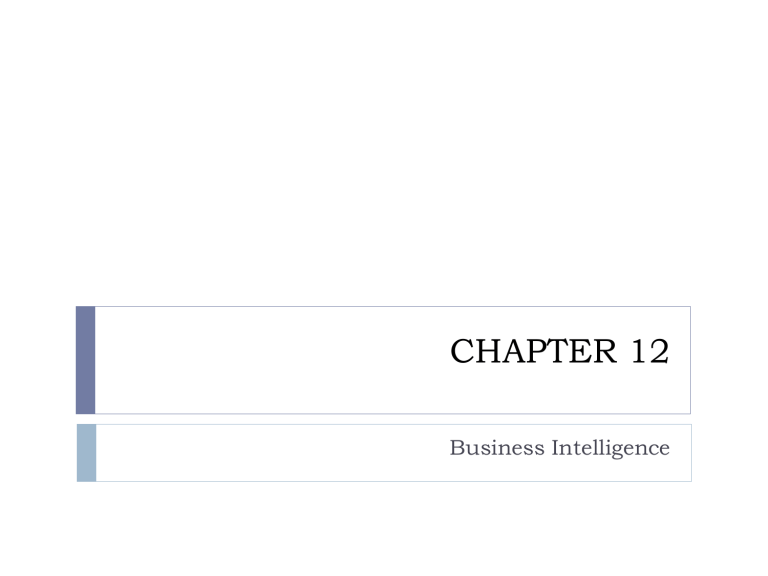
CHAPTER 12
Business Intelligence
CHAPTER OUTLINE
12.1
Managers and Decision Making
12.2
What Is Business Intelligence?
12.3
Business Intelligence Applications for Data Analysis
12.4
Business Intelligence Applications for Presenting
Results
12.5
Business Intelligence in Action: Corporate
Performance Management
The Manager’s Job and Decision
Making
Managers have three basic roles
(Mintzberg 1973)
Interpersonal roles figurehead, leader, liaison
Informational roles monitor, disseminator, spokesperson
Decisional roles entrepreneur, disturbance handler, resource allocator, negotiator.
The Manager’s Job & Decision Making
(continued)
Decisions and Decision making
Decision refers to a choice that individuals and group make among two or more alternatives.
Decision making is a systematic process composed of three major phases: intelligence, design and choice
(Simon 1977), with the implementation phase added later.
Decision Making Process
Why Managers Need IT Support
The number of alternatives to be considered constantly increases.
Decisions must be made under time pressure.
Decisions are more complex.
Decision makers can be in different locations and so is the information.
A Framework for Computerized
Decision Analysis
Problem Structure
The first dimension deals with the problem structure , where the decision making processes fall along the continuum ranging from highly structured to highly unstructured decisions.
Highly structured
Order entry
Semistructured
Loan approval
Higly unstructured
Building new plant
The Nature of Decisions
The second dimension of decision support deals with the nature of decisions
Operational control involves executing specific tasks efficiently and effectively.
Management control involves decisions concerning acquiring and using resources efficiently in accomplishing organizational goals.
Strategic planning involves decisions concerning the long range goals and policies for growth and resource allocation.
The Scope of Business Intelligence
Smaller organizations:
Excel spreadsheets
Larger organizations:
Data mining, predictive analytics, dashboards
Source: Dundas Software, www.dundas.com/ dashboard/online-examples/ screenshots/Marketing-Dashboard.aspx
How Organizations Use BI
Develop few, related BI applications
Data mart
Develop infrastructure to support enterprisewide BI
Enterprise data warehouse
Support organizational transformation
Enterprise data warehouse
12.3
Business Intelligence Applications for Data Analysis
Multidimensional Analysis or
Online Analytical Processing
(OLAP)
Data Mining
Decision Support Systems
© Toh Kheng Ho/Age Fotostock America, Inc.
Data Mining
Data mining refers to the process of searching for valuable information in a large database, data warehouse, or data mart.
Data mining performs two basic operations:
Predicting trends and behaviors;
Identifying previously unknown patterns and relationships.
Decision Support Systems (DSS)
DSS capabilities
Sensitivity analysis is the study of the impact that changes in one (or more) parts of a model have on other parts.
What-if analysis is the study of the impact of a change in the assumptions (input data) on the proposed solution .
Goal-seeking analysis is the study that attempts to find the value of the inputs necessary to achieve a desired level of output.
© STOCKBROKERXTRA/Age Fotostock America, Inc.
Digital Dashboard (example)
Source: MicroStrategy
Digital Dashboard
(example)
Source: Dundas Software, www.dundas.com/ dashboard/online-examples/ screenshots/Marketing-Dashboard.aspx
Digital Dashboard Demo http://www.informationbuilders.com/rfr/qtdemo/AdvVis_
ExecDash/AdvVis_ExecDash.html
12.5
Business Intelligence in Action:
Corporate Performance Management
FIGURE 12.7 1-8000 CONTACTS customer service agent dashboard.

